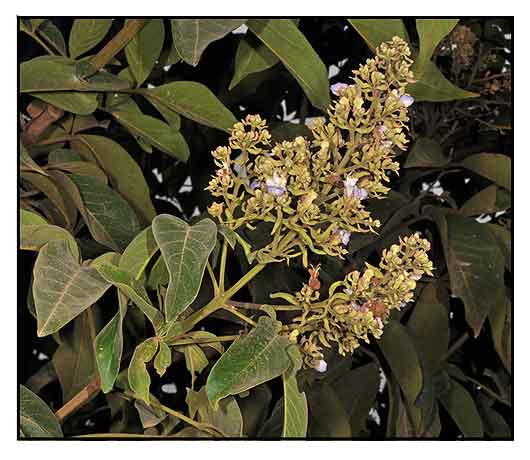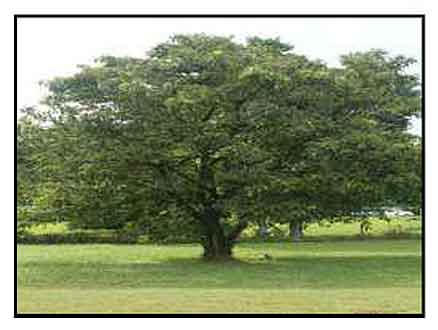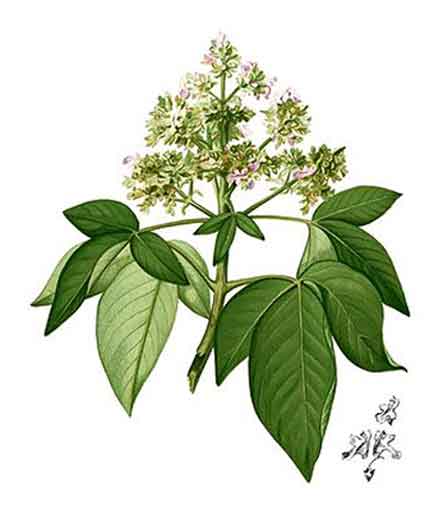 Gen info Gen info
- Vitex pinnata is a species of tree in the family Lamiaceae.
- The name "molave" is Spanish, derived from 'mulawin', the Tagalog word for the tree.
- In the confusing landscape of commom names, "molave" is shared by Vitex parviflora (Mulawin, small-flower chaste tree) and Viitex pinnata (hairy-leafed molave). Both species are native to the Philippines.
Botany
Molave is a tree that reaches a height of 8 to 15 meters, smooth or nearly so, with inflorescences that may be slightly hairy. Leaflets are three, stalked, ovate to lanceolate, 7 to 18 centimeters long, pointed at the tip, shining and quite smooth. Flowers are blue, numerous, 6 to 8 millimeters long, hairy outside the corolla, borne on terminal, paniculate and ample inflorescences, up to 20 centimeters in length. Fruit is rounded, 5 to 6 millimeters in diameter.
Vitex pubescens is a small to medium-sized evergreen tree, up to 25(-30) m tall, often with a crooked bole, up to 70 cm in diameter at breast height; bark surface smooth, shallowly fissured or flaky, pale grey to yellowish-brown, inner bark pale yellow to bright orange; branches quadrangular, crown often spreading. Leaves opposite, compound, (3-)5 foliolate; leaflets and petioles pubescent below; lateral leaflet sessile or nearly so, elliptic, 10-20 cm long. Inflorescence terminal, paniculate, with prominent bracts; calyx cup-shaped, 5-lobed, lobes subequal, c. 2 mm long, flowers bisexual, zygomorphic, corolla bluish-white to violet, 0.8-1.25 cm long, 2-lipped, upper lip 2-lobed, lower lip much larger and 3-lobed, pubescent outside; stamens 4, inserted on the corolla tube, exserted, didynamous. Ovary superior, 2-4-chambered, with 1 filiform style having a bifid stigma. Fruit a drupe, subglobose, 7-13 mm in diameter, purplish-black when mature, sessile on the often enlarged calyx, 1-4 seeded. Seed obovoid or oblong, lacking endosperm. (2)
Distribution
- Native to the Philippines.
-
Also native to Andaman Is., Assam, Bangladesh, Borneo, Cambodia, Himalaya, India, Jawa, Lesser Sunda Is., Malaya, Maluku, Myanmar, Sri Lanka, Sulawesi, Sumatera, Thailand, Vietnam. (1)
 Constituents Constituents
- Phytochemical study of V. pinnata isolated a mixture of steroids ß-sitosterol and stigmasterol (1a and 1b) and three known flavonoids identified as 5-hydroxy-3,7,4'-trimethoxyflavone (2), 5-hydroxy-7,4'-dimethoxy-flavone (3) and 5-hydroxy-3,3',4',7-tetranethoxyflavone (4). (5)
- GC-MS study of ethanol extract of leaves yielded major chemical constituents of 3,7,11,15-tetramethyl-hexadecen-2-en-1-ol, gamma-stigmasterol, 9,12,15-octadecatrienoic acid and n-hexadecanoic acid. (see study below)
(8)
- Study of bark isolated one new iridoid glucoside, pinnatoside (1), and three known flavonoids, viscioside (2), apigenin (3), and luteolin (4). (see study below) (10)
Properties
- Studies have suggested antibacterial, antifungal, antioxidant, wound healing, estrogenic, anti-inflammatory, antitrypanosomal, cytotoxic properties.
Parts used
Leaves, bark, roots.
 Uses Uses
Edibility
- Leaves are edible. Use for making herbal tea.
Folkloric
- Leaves and bark used for stomachache. Poultice of leaves used to treat fevers and wounds.
- Roots and bark used for herbal baths.
- Aceh people of Indonesia use leaves to treat hypertension, fever, toothache.
- Kutai and Dayak people of Kalimantan, Indonesia, consume ground seeds to cure malaria.
- In Sri Lanka, bark decoction prescribed for diarrhea. Leaf infusion used to wash diseased skin. Dried bark powder applied on forehead to relieve headaches. (3)
- Roots used to relieve backache, body ache, and fatigue.
Others
- Wood: Brown, hard and durable. Unlike Vitex parviflora, the timber is not of commercial importance because it is not available in larger dimensions. Locally, it is used for construction, boats, implements.
- Fuel: Produces high quality charcoal.
Studies
• Antitrypanosomal Activity: Phytochemical study of V. pinnata isolated a mixture of steroids ß-sitosterol and stimasterol (1a and 1b) and three known flavonoids identified as 5-hydroxy-3,7,4'-trimethoxyflavone (2), 5-hydroxy-7,4'-dimethoxy-flavone (3) and 5-hydroxy-3,3',4',7-tetranethoxyflavone (4). Compounds 1-4 showed moderate antitrypanosomal activity against Trypanosoma brucei brucei with MICs of 6.25 µg/ml, 19,0, 21.0, and 17.0 µM, respectively. (5)
• Toxicity by Brine Shrimp Lethality Test / Fruit: Toxicity test was done to determine safe limit of concentrations that can be consumed without causing side effects, using Brine Shrimp Lethality Test (BSLT) with Artemia salina Leach shrimp larvae. The ethanolic extract of laban fruit was toxic with LC50 of 600,608 mg/mL. (6)
• Antibacterial / Leaves: Vitex pinnata is known to inhibit the formation of Streptococcus mutans in human teeth. Study evaluated the antibacterial activity of various extracts of Laban leaves against Streptococcus mutans, the MIC and minimum kill concentration. The methanol extract inhibited bacteria more quickly and at smallest concentration of 0.05% average colony-1.48 CFU/ml. The smallest concentration of extracts (n-hexane, ethyl acetate, and methanol) is able to kill S. mutans bacteria. (7)
• Estrogenic Activity and Effect on Lipid Profile / Leaves: Study evaluated the estrogenic activity and lipid profile of ethanol extract of leaves of V. pinnata with 17 ß-estradiol in bilaterally ovariectomized (OVX) rats. The extract at dose of 1000 mg/kg significantly increased uterine and vaginal weight and endometrial thickness. Doses of 500 and 1000 mg/kb induced significant (p<0.05) decrease in triglycerides and total cholesterol in OVX rats. Results may be of benefit for postmenopausal women. (see constituents above) (8)
• Antioxidant / Antibacterial / Wound Healing: Study evaluated the antioxidant, antimicrobial, and wound healing properties of methanol extract of leaves V. pinnata fractionated with hexane, chloroform, and ethyl acetate solvents. All extracts showed antioxidant activities, with the EA extract showing highest DPP)H radical scavenging activity. On disc diffusion assay, the ethyl acetate extract showed antibacterial activity against all four tested strains i.e., S. aureus, B. subtilis, E. coli, and P. aeruginosa. On wound healing studies, ointment formulation of 50% (w/w) showed significant wound contraction in excision wound model in Wistar rats. (9)
• Antifungal / Bark: Study of bark isolated one new iridoid glucoside, pinnatoside (1), and three known flavonoids, viscioside (2), apigenin (3), and luteolin (4). Compound 1 exhibited modest antifungal activity against Candida albicans. (10)
• Anti-TB / Cytotoxicity / Bark: GC-MS study
evaluated the chemical profile of V. pinnata (VP) bark lipophilic extract and its anti-TB and cytotoxic activities. GC-MS revealed a total of 81 compounds representing 86% of identified compounds. In silico docking study on major identified compounds, showed n-nonane with the most favorable binding affinity. In vitro anti-TB of V. pinnata lipophilic extract using Microplate Alamar Blue Assay exhibited MIC of 62.5 µg/mL. Results suggest potential use of the V. pinnata extract as a natural anti-TB. (11)
• Effect of Leaf Toothpaste Formulation on Saliva pH: Maintaining pH balance of saliva is one way of preventing dental caries. The pH balance is influenced by the rate of salivary secretion, which can be stimulated chemically or mechanically. Study evaluated the effect of use of laban leaf methanol leaf extract on salivary pH. Results showed the use of methanol extract toothpaste of laban leaves was more effective in increasing salivary pH (p<0.05). Results suggest potential of laban leaves as raw material for toothpaste. (12)
Availability
Wild-crafted.
|

![]()





 Uses
Uses 